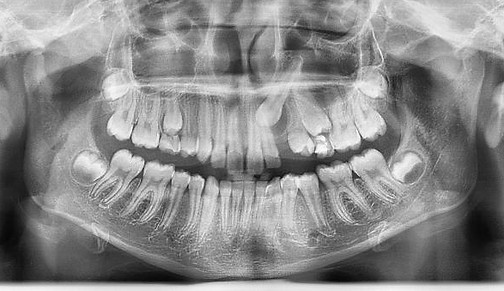Website last up-dated January 2020
Anna Gibilaro
rthodontics
Dr Gibilaro's practice has closed.
If you are an old patient and would like to see another orthodontist either ask your dentist or doctor for another recommendation, or contact Dr Sarah Burns: 40-41 Wimpole St, London W1G 8AB Phone 0800 151 2468
Treatment for Impacted Canines
In around 2% of the population the upper adult canines become impacted (stuck in the bone of the jaws) and do not come into the mouth. Lower canines can also become impacted but this is rarer.
Most of the upper canines that become impacted are displaced to the palate side of the dental arch.
Most impacted upper canines will never spontaneously come through the gum into the mouth. Occasionally the canine will break through the gum in the palate region; the canine will not spontaneously align itself even if it emerges through the gum.
Impacted canines often run in families and can also be associated with other dental problems such as small or missing lateral incisor teeth.

Radiograph (x-ray) showing impacted canine in a 14 year old girl.
Problems with Impacted Canines
If an impacted canine is not treated it will stay in the bone of the jaws. The baby canine will sometimes stay in place for many years but is usually lost at some stage leaving a gap.
The impacted canine can cause problems if left in the jaw bone. The roots of the adjacent teeth can resorb (start to disappear) and in severe cases the adjacent teeth can be lost as a result of this.
The upper adult canine usually comes into the mouth at around 12 years of age.
At the age of 10 years an orthodontist should try to palpate (feel with a finger) the upper canine under the gum. If it cannot be felt a radiograph should be taken to check that the canine is developing in the correct position. If there is evidence that the upper adult canine has started to drift towards the palate then the treatment recommended is to remove the baby canine (usually both left and right baby canines would be removed to prevent the front teeth from moving to the side where a tooth has been lost). Over the next year to 18 months the position of the upper canine should be monitored to see whether spontaneous correction occurs and it comes into the mouth.

Baby canine still in place in 13 year old girl. A radiograph showed the adult canine was impacted in the palate.

Baby canine still in place in 15 year old boy. A radiograph showed the adult canine was impacted in the palate.



Upper left and right baby canines still in place in 21 year old woman. A radiograph showed that both the upper adult canines were impacted in the palate. The lower left canine was also impacted although the baby canine had been lost.
Treatment of Impacted Canines
There are always treatment options to discuss with impacted canines. These options are:
-
No treatment; keep impacted canine under observation. This is not usually the treatment of choice for a child but maybe for an adult where the space for the canine has closed and the paternity does not want orthodontic treatment.
-
Remove the impacted canine with a surgical procedure and either leave the baby canine in place, accept a gap if the baby canine has been lost, or replace the canine with a bridge or implant, or close the space with orthodontic treatment if it has not closed spontaneously.
-
Auto-transplant the impacted canine from the palate into the correct position. If the impacted canine is severely displaced and not possible to re-position with orthodontic treatment, it is sometimes possible for a surgeon to remove it and create a socket for it in the correct position and transplant it. Orthodontic treatment may or may not be needed in this treatment option depending on the position of the other teeth.
-
Exposed and bond the impacted canine and bring it into the correct position with orthodontic appliances. This is usually the treatment of choice to treat impacted upper canines, especially in children when the treatment is much easier and more predictable. In this option the impacted canine is surgically uncovered (exposed) and an attachment, usually with a gold chain, is secured to it. The canine is then it is covered up again by the gum with a part of the chain emerging through the gum so that orthodontic appliances can be used to pull it into the correct position.

Baby canine still in place in 13 year old girl. Orthodontic appliance used to open up more space to accommodate a larger adult canine that is impacted.

Later on in treatment the space has been opened and the impacted adult canine exposed and bonded leaving a gold chain emerging through the gum.
Before and after pictures of orthodontically treated impacted canines


Case 1: 21 year old woman with impacted upper left, upper right and lower left canines.


Case 2: 23 year old woman with impacted upper left and upper right canines.

